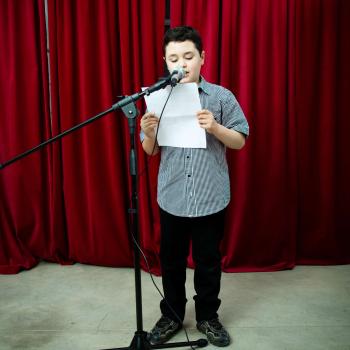Performing Poetry

About this Strategy Guide
Performing poetry can be used to integrate reading across the curriculum. Students read with expression, using their voice and gestures to convey the meaning of the text. With repeated readings of a poem, students become fluent readers and increase their comprehension.
Research Basis
Support for the multifaceted nature of performing poetry is found in several reading theories and educational paradigms including Dowhower (1987), Rosenblatt (1978), Samuels (1979), and Schreiber (1980). More recently, Wilfong (2008) indicated that repeated reading of poetry improves fluency and attitude toward reading. Through repeated readings of the text, students increase sight word vocabulary and the ability to decode words quickly and accurately. In addition, the repeated readings allow students to use appropriate sentence phrasing, read punctuation markers, and read with greater ease. This fluent reading enables students to spend less time on decoding and have greater comprehension of the text (Pikulsi & Chard, 2005).
Performing poetry also allows students to read the poem through an interpretive process, using intellect and emotion to comprehend the content of the poem.
Strategy in Practice
- Choose a poem to enrich, reinforce, or teach content subject matter. On some occasions, give students the opportunity to locate or write a poem instead.
- Distribute copies of the poem to students. If possible, also make the poem available on a large sheet of paper or project it on the board.
- Model fluent reading by reading the poem orally while the students follow along with their printed copy. Discuss the content of the poem and encourage students to share their reactions.
- Identify unfamiliar words by highlighting them with a pen or tape on the large copy of the poem. Discuss the meaning of these words.
- Read the poem again and have students join you in the reading. Model reading with expression and include volume, pitch, and tone when appropriate and pay attention to punctuation markers.
- Continue with students reading alternating stanzas, verses, or lines with a partner or in a small group.
- Discuss the content of the poem, especially to teach specific information in literacy (e.g., phonograms, word families) or in another content area (e.g., math, social studies, science).
- If students are reading their own creations, have them repeat read their poems with a partner or small group.
- On performance day, the students can read all or part of the poem either individually or in a group.
-
Poetry Parade—Students parade to another classroom and recite their poetry. Students carry large cutouts or pictures to provide a visual for the viewers, with the poem attached to the back.
-
Poetry Day—On a given day of each week, students can read a poem of their choice to their class.
-
Poetry Theatre—Transform your classroom into a theater and have students read poetry individually or in groups to the audience. Invite parents or other classes to attend.
-
Poetry Café—Transform your classroom into a café and have students orally read poetry to their classmates, family members, and/ or members of the school community.
-
Poetry Night—Invite parents and member of the community to listen to students read poems. These poems can be their own choice or their own creation.
-